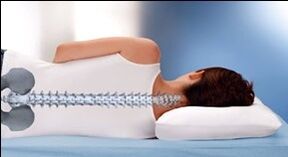
Ask the question: How to treat osteochondrosis in the cervical spine, there is an answer: If you are not in the acute period, please yourself the cause of this disease.
Medical Treatment Investigation - Symptoms of the disease, not the cause.So don't hope the doctors, don't spend money on ointments, teas, injections, physical therapy, simulators, massages in vain.None of the funds listed helps you.
So it is clear that my personal experience in treating cervical bone cartilage, I would love to share, hopefully it will help one of you to deal with this problem.
However, the success of the treatment will depend on several conditions:
- Your desire to help yourself;
- Prepare to understand the real causes of cervical osteochondrosis;
- Comply with the strictest self-discrimination in treatment.
What you need to know about osteochondrosis in the cervical spine
Answer this question:How to treat osteochondrosis in the cervical vertebraeIt is necessary to have a good understanding of the causes of the disease.To understand it, you will have to turn to the anatomy of the spine.
Our spine is important, but flexible, for important vascular and nerve trunks.Supporting the spine in good condition means no health problems.
However, we have been careless about our spine from childhood out of ignorance or due to a rash attitude towards health: overloading, uncomfortable postures, sitting on a computer or desk for hours while sitting on a workplace, we spend a lot of time driving in a tight state, we have overweight, incorrect postures, and so on.

The cervical spine is the most moving.It consists of seven vertebrae, which have elastic intervertebral discs.They are obviously visible in the figure.The disc makes the spine flexible while giving it strength.
Each intervertebral disc consists of an annulus with a pulp pulposus.
In the cervical spine, the cerebrospinal nerves and vertebral arteries pass through branching nerves and blood vessels, which not only feed the head with the brain, but also the organs of the shoulders.
Cervical osteochondrosis is a change in the cervical disc due to physical, inflammation or mental exposure.The elasticity and strength of the intervertebral discs are reduced, and their height is also reduced.
In the future, if you do not treat the disease, the annulus of the intervertebral disc will be squeezed and deformed, which may lead to protrusion.In more severe cases, the annulus of the intervertebral disc is disconnected and the pulp pulposus protrudes in the form of a hernia while squeezing the ends of the nerves exposed from the vertebrae, as shown.
Therefore, the cause of cervical osteocartilage degeneration is the change of the cervical intervertebral disc in a weak muscle background.In addition, even a slight muscle tone can cause displacement of the vertebrae, so the nerve ends are compressed and pain occurs.
But there are many factors, so the disk changes.It is a sedentary lifestyle, hereditary tendencies, metabolic diseases and injuries, and salt deposition in the cervical spine and others.
How does cervical osteochondrosis manifest?All symptoms indicate impaired innervation and blood supply to the brain, head, neck and shoulder straps due to changes in the intervertebral disc.Therefore, the symptoms of cervical osteochondrosis are headaches on the head and the back of the temple. Dizziness, sharp head, noise in the ears, decreased vision, hearing loss, neck, shoulders, shoulder blades, hands, and sometimes heart pain.
Dizziness, sharp head, noise in the ears, decreased vision, hearing loss, neck, shoulders, shoulder blades, hands, and sometimes heart pain.
If cervical osteochondrosis is not treated, diseases such as migraine, hypertension, plant vascular dystonia, hearing problems, eyes, coordination and cardiovascular and respiratory systems due to impaired brain circulation.In advanced cases, cerebral ischemia and stroke may occur.
Personal experience in the treatment of cervical osteochondrosis
The diagnosis is cervical osteochondrosis, and I gave me a neuropathologist at the age of 45.After looking at the X-ray picture of my neck, he wrote on the card next to the diagnosis: The height of the disc between the C5-C6 and C6-C7 vertebrae was greatly reduced.I was suffering from frequent headaches, my ears sounded, and my neck pain.
The problem arises:How to treat osteochondrosis in the cervical vertebrae.The doctor calmly "rest me" because the disc is deformed and osteochondrosis cannot be completely cured.He prescribed my ointment for those prices for me who were not cheap and suggested that I sit directly at the table.It was the 90s and I bought ointments based on recipes from some neuropathologists in the left pharmacy.But the ointment of relief did not bring it, and the pain poisoned my life.
Based on the advice of an acquaintance, I turned to the services of paid experts with a higher medical education in manual therapy.After he felt his cervical spine turn around my head, it seemed to be 180 degrees and it became easy, enlightened without pain.However, the program is obviously dangerous.The Manoist warns that you need to sit directly at the table for three days, rather than the position you like.

I followed the advice for two days and then forgot.A few days later, my condition was the same as going to the doctor-manualist.This experience taught me how to treat osteochondrosis in the cervical spine.Rereading all the literature on osteochondrosis, I realized that I had to independently affect the cause of the disease.The doctor here is not an assistant.It is impossible to change the deformation of the intervertebral disc, but you can stretch your cervical spine, which reduces the pressure on the ends of the nerves and blood vessels.
In the house we always have a level bar that hangs on it in the morning and besides the neck you get a nice whole spine.I have tried a variety of ways to stretch my neck and developed my own system to treat cervical osteochondrosis:
- Changed her posture.It wasn't easy and didn't happen immediately, but self-binding and motivation helped me feel healthy.I often look at my position in the mirror, check it, and get close to the wall: my head should touch the wall, that is, in the same line as the high heels.I always try to hold my head and shoulders.Today, when I was 60, my posture was better than twenty years ago.
- Every morning and evening, I will perform "turtle" from the Dao Revitalization System.Sometimes, if I feel nervous or intensified around my neck, upper back, or shoulders, I do this more often.A turtle sitting like a sitting turtle:
- Lower the chin on your chest and pull your head back with your head.Inhale slowly.At this time, the back of the neck is stretched and the shoulders are lowered.
- Exhale slowly, bringing the back of your head down as if you want to touch them to the back of your neck.The chin stretches, the throat stretches slightly.The shoulders were raised on both sides of the head, as if they were trying to touch their ears.
- Repeat this cycle 10-12 times, trying to do everything slowly.
The turtle's exercise helps to safely stretch the cervical spine, strengthens the muscles of the neck and shoulders, eliminates fatigue, hardening and pain, improves metabolism and rejuvenates the body.
- In addition to "turtle"
- Raise and lower your shoulders 10 times; tilt your head slowly to the left - each shoulder 10 times to the right;
- Slowly lean your head forward - backward 10 times;
- First tilt your head to the right (the right ear of the right ear), then slowly, stretch your neck and throw the head away, rolling it onto your spine, left shoulder.Then from the left shoulder - to the right.Make 10 cracks on each shoulder;
- Relax, straighten your spine again, balance the weight of your body on your tailbone, and then start slowly performing a circular motion with your left to right torso and then 10 times from right to left.Meanwhile, head, shoulders, and hands rotate and relax.
In addition to relaxation, the exercise awakens the body’s healing power and normalizes the energy and nutrition of all cells and organs.
- When I worked on my computer for a long time, I put on my neck collar (available in the pharmacy).I didn't sit in it for an hour or two.This allows you to straighten your head.
- For example, if I notice an awkward position, for example, sitting by TV or working in the countryside, my ears or headaches will ring and I relax immediately (as read here), after which I will exercise the turtle.Calls and pain pass within 5-10 minutes.

The muscle relaxation and stretching of the neck and shoulder straps should be part of your daily life, and then you will feel great and have a diagnosis of cervical bone cartilage.
Consult your doctor before starting your practice.
Here, I want to note that the treatment of this disease may be exacerbated.If your cervical osteochondrosis is acute invading the nerves that are hypothermia or any infected, then go to the doctor and perform prescribed lockdowns, injections, etc.
You also noticed: You can relax your neck muscles by taking a hot shower around your neck or being showered with a hot water in the bathtub.
Live a moving lifestyle, but due to tight shoulder muscles, avoiding sharp turn of the head, a huge burden, its spasms can transfer vertebrae and erosive spasms to the roots of nerves and blood vessels in the upper neck.
Sleeping on a small pillow in fresh air usually turns negative thoughts into positives so that your stress does not scatter the cervical spine and shoulder areas and does not exacerbate the symptoms of bone cartilage bone.

Adhere to proper nutrition.Exclude sugar and white bread, bakery products in the diet.Eat more vegetables, fruits and grains.
Now, I hope you understand how to treat osteochondrosis in the cervical spine.
Believe in yourself, neck osteochondrosis without pain!






















